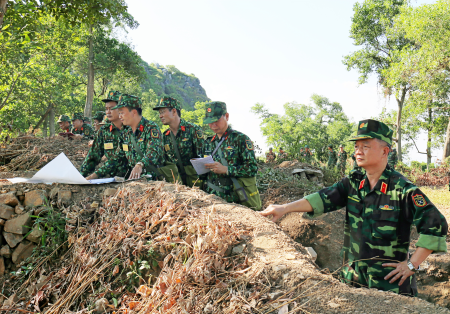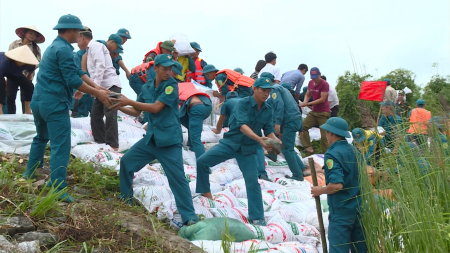To make the Military Region 3’s armed forces strong and capable of playing a core role in performing the military-defence task
In the history of national construction and protection, the Military Region 3 always holds a position of critical importance to the country’s politics, economy, culture, defence and security. Under the leadership by the Party, particularly the Central Military Commission and the Ministry of National Defence, the Military Region 3’s troops and citizens have achieved brilliant feats of arms to contribute to liberating the country, constructing and defending the Homeland, and building up the tradition of “solidarity, proactiveness, creativity, sacrifice, and victory.”
After its establishment, the People’s Republic of Vietnam was confronted with numerous difficulties and challenges. To effectively lead, command and build the armed forces, on October 31st, 1945, President Ho Chi Minh signed the Decree on founding the War Zone 2 and the War Zone 3 (the present-day Military Region 3). In the war against the French colonialists, the Inter-Zone 3’s armed forces cooperated with others in organising large-scale campaigns, such as Dong Bac II (1949), Hoang Hoa Tham (1951), Quang Trung (1951), and Hoa Binh (1951 - 1952) as well as a counteroffensive in Southwestern Ninh Binh (1953). At the same time, they enhanced the guerrilla war to annihilate the enemy’s strength, with the campaigns of “Route 5,” “Cat Bi”, and “Route 10” inflicting panic and heavy losses on the enemy and making contributions to gaining the victory of Dien Bien Phu and liberating the North.
In the war against the US imperialists, for national salvation, the Military Region 3’s citizens heightened the revolutionary spirit via the movements, such as “one person works as much as two for the South,” “one hand with hammer, the other with gun,” “youth maintain readiness for 3 tasks,” “women take charge of 3 tasks,” together with many five-ton provinces, such as Thai Binh, Nam Ha, and Hai Hung. “All for the front line” and “All against the U.S. invaders” became slogans of each soldier and citizen. With many creative approaches and movements, such as “launching a guerrilla war in the air,” “conducting a guerrilla war at sea,” “on-the-spot and mobile militia and self-defence force,” “each citizen is a combatant, a political employee, and a logistics worker,” and “each family is a combat team,” the Military Region’s troops and people established an extensive, focalised, multi-layer, multi-direction posture to defeat the U.S. operations of “Pierce Arrow,” “Sea Dragon,” and especially “Linebacker II” in late December 1972, greatly contributing to making the victory of “Dien Bien Phu in the air,” liberating the South, reunifying the country.
With their feats of arms and achievements gained over the past 75 years, the Military Region 3’s armed forces were presented with two Gold Star Orders, three Ho Chi Minh Orders, five Independence Orders, one First-Class Military Exploit Order, and thousands of other noble medals by the State. 830 units and 322 individuals from the Military Region were given the title of Hero of the People’s Armed Forces, while over 19,000 women were awarded the title of Heroic Vietnamese Mother. In today’s national construction and protection, the Military Region’s Party Committee and Command will well perform several central tasks as follows.
First, the Military Region will continue to grasp and effectively implement the Party’s resolutions and directives and the State’s law and policy, particularly resolutions by all-level party congresses, strategies, projects and resolutions on the military-defence work in accordance with its particularities. It will also grasp the situation, particularly in the key, border, sea and island areas, while strictly maintaining the order for combat readiness to avoid passivity. It will continue effectively executing the Project on renewing political education at military units in the new period and the Project on propagating the Military’s production and economic development associated with defence consolidation. Due attention will be paid to providing political and ideological education, building troops’ political zeal, making them absolutely loyal to the Homeland, the Party, the State, and the people, and encouraging them to readily undertake and fulfil all assigned missions. The Military Region will well implement the Campaign entitled “promoting tradition, devoting talent, deserving to be Uncle Ho’s soldiers” in the new period together with the 12th Politburo’s Directive 05-CT/TW and the Central Military Commission’s Directive 87-CT/QUTW on the study and following of Ho Chi Minh’s ideology, ethics and lifestyle. It will enhance the work of internal political protection, ensure secrecy and security of its operations, and build safe units and areas. Besides, due regard will be paid to renewing and improving mass mobilisation and the work of special propagation, performing the function as “an army ready for work,” taking part in building new-style countryside and civilised urban areas, and making political bases increasingly strong.
 |
| Commander of the Military Region 3 directs an exercise by the Division 395 |
Second, the Military Region will promote its core role in building the all-people national defence and the posture of all-people national defence associated with the people’s security posture and the posture of “people’s hearts and minds.” Consideration will be given to closely combining the building and operation of provincial and municipal defensive zones with the Military Region’s defence to create an inter-connected, solid defensive posture. The Military Region will closely lead and direct defensive zone exercises by departments, sectors and localities and drills on natural disaster prevention and control, search and rescue as well as the development of plans/projects on civilian defence. Importance will be attached to raising the effectiveness of the mechanism for the Party’s leadership and authorities’ management and improving all-level military offices’ capacity to give advice to local party committees and authorities on the military-defence work. The Military Region will closely cooperate with local party committees and authorities in implementing the Law on the Militia and Self-Defence Force and the Law on the Reserve Force as well as in building specialised, standing, and coastal militia and self-defence units in the key areas. It will direct coastal provinces’ military commands to work with the Border Guard Force and the Public Security Force to give advice to local party committees and authorities on leading, managing, operating, inspecting and supervising the work of national border protection. Great value will be attached to executing the Project on “building and engaging standing coastal militia squadrons in the defence of sea and island sovereignty in the new situation.”
The Military Region will cooperate with localities in settling issues relating to national defence land and constructions. It will realise plans on national defence disposition in line with socio-economic development projects in the period of 2021-2030. Besides, it will promote the armed forces’ role in maintaining political security and social order and safety as well in protecting significant political events of the country and localities.
Third, it will adjust its organisational structure in a “compact and strong” manner. Due attention will be paid to grasping and stringently executing the Politburo’s Conclusion 16-KL/TW and the Central Military Commission’s Resolution 606-NQ/QUTW on the Military’s force organisation towards 2021 and the Project on organising the Vietnam People’s Army in the period of 2021-2025. Priority will be given to sufficiently staffing units tasked with combat readiness in the key, border, sea and island areas and reducing the strength of logistics-technical units and local military agencies. The work of recruitment, salary rise, and professional conversion amongst professional military personnel and defence labourers will be closely carried out. Emphasis will be placed on completing the organisational structure of the cyber warfare force and several newly-founded units, rearranging the system of schools, restructuring the Economic - Defence Corps 327, and implementing the master project on autonomy of public service units.
 |
| The armed forces of Kim Son district (Ninh Binh province) take part in natural disaster prevention and control |
Fourth, the Military Region will focus on renewing and improving the training work, and grasping the viewpoints, targets, requirements and measures for raising the quality of troop training to meet the requirements set by combat readiness and combat. It will manage and operate the training work in a “focalised, uniform, effective and synchronous” fashion. Importance will be attached to synchronously providing intensive training courses relevant to combat reality, training troops to master weapons and technical equipment, particularly the new ones, and combining combat training with physical training to enhance troops’ manoeuvrability in any circumstance. The Military Region will improve the quality of training, joint exercises, and combat coordination between forces within defensive zones, especially the anti-terrorism forces, while continuing to raise the quality of training the militia and self-defence force and the reserve force in accordance with each force’s organisational structure and task and each area’s particularities. It will effectively implement the Project on basically, comprehensively renewing education and training and make more investments in facilities and equipment for training and scientific research. Measures for military standard order building and discipline management will be enhanced. Great weight will be added to multiplying comprehensively strong, “exemplary and typical” units across the Military Region’s armed forces. Due regard will be paid to building troops’ law-abiding awareness, managing their ideology and social relationships, and improving their material and spiritual life.
Fifth, the Military Region will opportunely, sufficiently ensure logistics and technical materials for training and combat readiness, with priority given to units stationed in the border, sea, island, remote, isolated areas. It will renew and make the method of logistics support relevant to its armed forces’ task requirements, while raising the effectiveness of the logistics work within defensive zones. It will direct its affiliates to develop animal and crop husbandry properly and improve their facilities. Units and offices within the Military Region will well conduct the work of epidemic prevention and control, ensure food safety and hygiene, provide health care for troops, and improve troops’ life. Moreover, the emulation movement titled “the Military Logistics Branch follows Uncle Ho’s teachings” will continue to be effectively executed. Measures for renewing logistics support and the new mechanism for military financial management will be synchronously implemented. Weapons, equipment and technical support will be qualitatively, synchronously provided for units tasked with training, combat readiness, search and rescue as well as airspace, border, sea and island protection. Emphasis will be placed on enhancing the quality of materiel preservation, maintenance, repair and storage and the Campaign 50 to create a huge positive change in the technical work and traffic safety.
Those achievements over the past 75 years will give cadres and soldiers of the Military Region 3’s armed forces an incentive to promote the tradition of “solidarity, proactiveness, creativity, sacrifice, and victory,” build a pure, strong, typical Party Organisation, and make the Military Region’s armed forces comprehensively strong and capable of undertaking and successfully fulfilling all assigned tasks.
Maj. Gen. NGUYEN QUANG NGOC, Commander of the Military Region 3